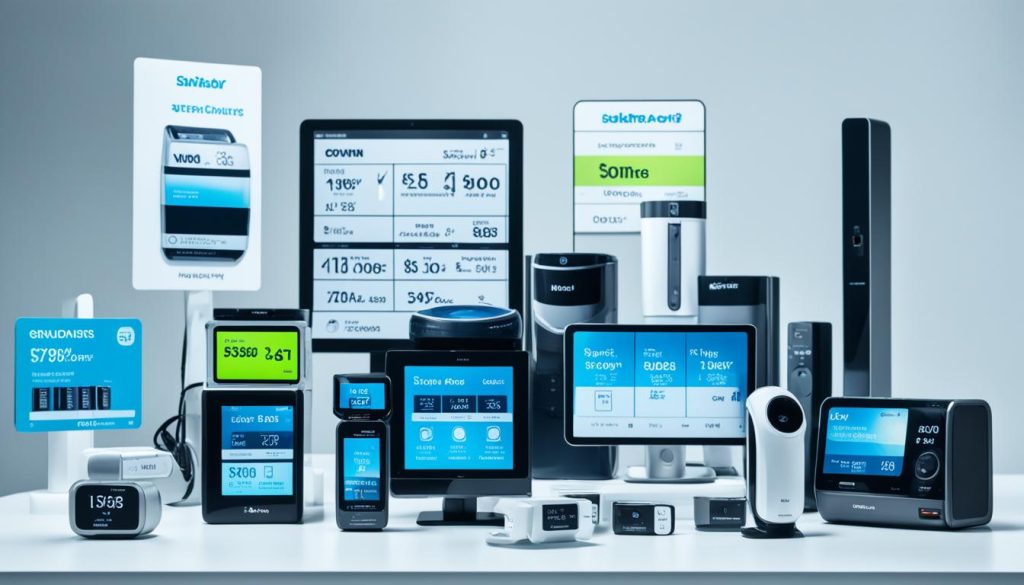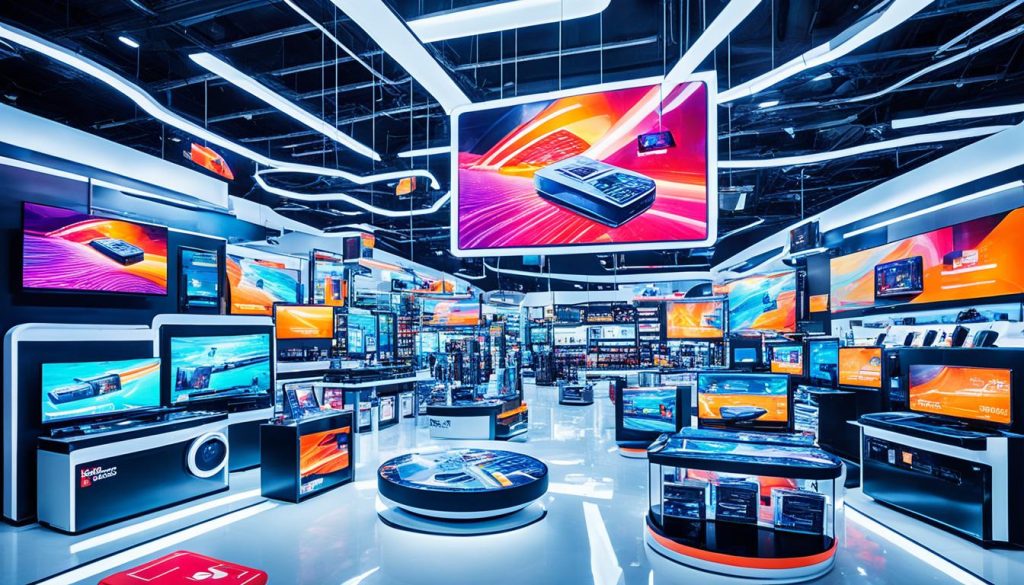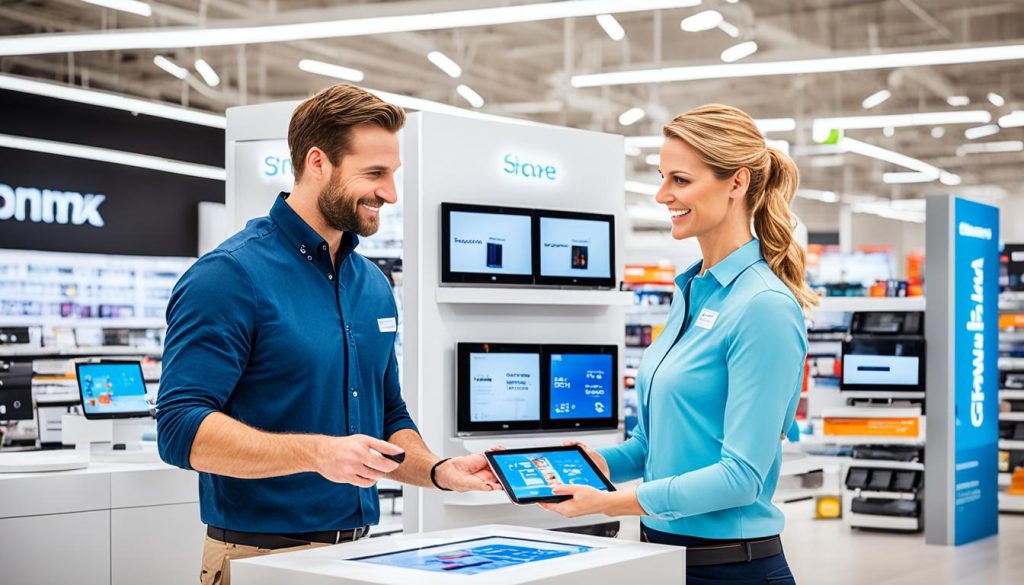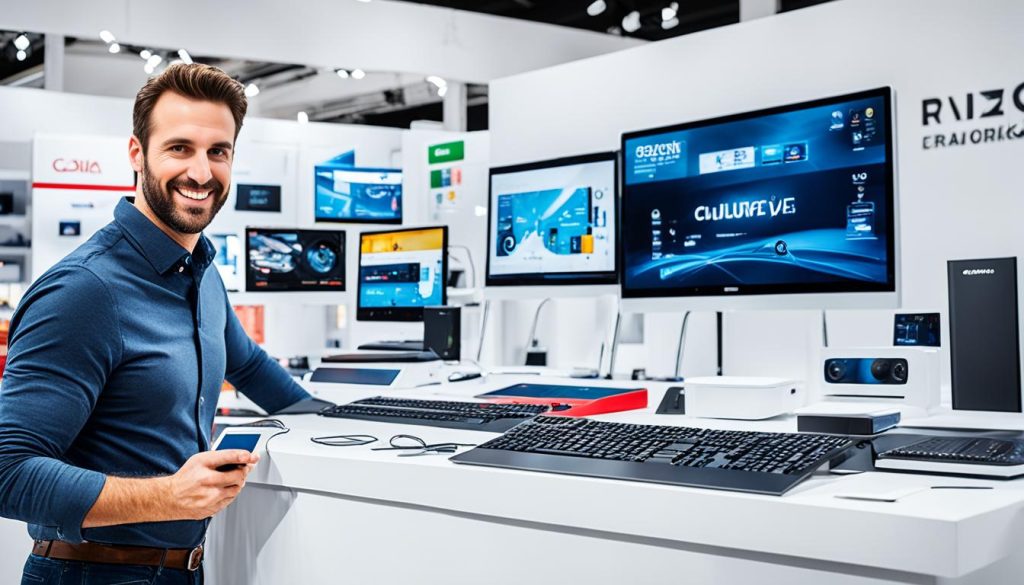Richard Branson once said, “Business opportunities are like buses, there’s always another one coming.” This is very true for the retail world, especially in Italy’s booming electronics sector. For UK entrepreneurs, starting an electronics store is a great way to make your business dreams come true. It also lets you tap into Italy’s growing need for tech products.
This guide will help you set up your own electronics store in Italy. We’ll cover everything from market research to legal stuff and managing your stock. Get ready to see the exciting opportunities that await you in electronics entrepreneurship.
Key Takeaways
- Explore the significant demand for electronics in Italy.
- Understand the market dynamics and key demographics.
- Familiarise yourself with legal requirements for business registration.
- Assess the ideal location based on urban versus rural considerations.
- Learn effective inventory and pricing strategies.
- Implement impactful marketing techniques to attract customers.
- Emphasise creating a customer-centric shopping experience.
Understanding the Electronics Market in Italy

The electronics market in Italy is always changing, showing how tastes of consumers are evolving. There’s been a big rise in demand for new technologies lately. This part looks at the latest trends in the electronics world and who buys these products. It aims to help businesses make better plans.
Current Trends in the Electronics Industry
Smart home devices are a big deal in Italy now. People want things that make life easier and more efficient, like smart thermostats and security systems. Also, there’s a growing interest in renewable energy tech because of a focus on being green. Augmented reality is also changing things, offering new ways for users to interact with products.
Keeping up with these trends is key for businesses wanting to do well in the competitive electronics market.
Key Demographics for Electronics Consumers
Knowing who buys electronics helps with marketing. Young adults, especially those 18-34, are a big part of the market. They look for the latest tech and quality. Income matters too, with those in the middle to higher income groups more likely to buy premium products.
Understanding these groups helps in finding the best markets and making marketing more effective.
Legal Requirements for Setting Up Your Store

Starting an electronics store in Italy means following important Business Legal Requirements. This includes steps to meet local laws. First, you must register your business with the local Chambers of Commerce.
Business Registration Process
The registration process is key for those wanting to do business in Italy. You need to pick a legal form for your business, like a sole proprietorship, partnership, or corporation. Then, you must prepare the needed documents, such as your ID and a business plan, and submit them to the right authorities.
Tax Obligations and Licenses
After registering, you must handle your tax duties. In Italy, getting a VAT number is vital for sales and tax matters. You also need specific licenses for selling electronics, based on your products. It’s important to know about tax laws and licenses to stay legal.
Health and Safety Regulations
Health and safety rules are vital for an electronics store. Owners must follow local health standards to protect staff and customers. This means having proper signs, emergency exits, and keeping electrical gear safe. Knowing and following these rules makes your store safe and welcoming.
Choosing the Right Location for Your Electronics Store

Finding the perfect spot for your electronics store is key to success. Deciding between city and countryside locations affects how well you’ll do. You need to think about how visible, easy to get to, and competitive the spot is.
Considerations for Urban vs. Rural Areas
City stores get more people walking by because there are more people and better transport. These customers might buy things on a whim. But, rural spots have fewer shops and might not get as many customers. You should think about:
- Population and how people act.
- How close you are to other shops and businesses.
- How easy it is for customers to get there.
- The cost of renting or buying a shop.
Impact of Foot Traffic on Sales
How many people walk by your store really matters for sales. Being in a busy city spot can make more people see your brand and buy things. Watching where people go helps you set the best times and deals. Important things to remember include:
- How local events and places affect people coming by.
- How many people come by during different seasons.
- Ways to get and keep customers coming in.
- Using window displays to catch people’s eyes.
Identifying Your Target Audience

Knowing who your customers are is key to doing well in the electronics retail market. Good market research shows what your potential customers like and how they behave. This includes different methods to learn about how people buy electronics.
Market Research Techniques
To find out who your audience is, use these market research methods:
- Conduct surveys to gather feedback on product preferences.
- Analyse online shopping trends through website analytics tools.
- Utilise focus groups to understand consumer motivations.
- Monitor social media for insights on brand perceptions.
- Study competitors to identify gaps in the market.
Consumer Behaviour Patterns in Electronics
Looking at how people shop for electronics shows us what they prefer. Customers often:
- Stick to brands they trust because of good reviews.
- Do their homework online before buying.
- Watch out for deals and sales.
- Want the newest tech and its features.
Knowing these habits helps businesses make products and services that meet what their customers want.
Electronics Store Inventory Management

Managing your electronics store’s inventory is key to doing well. Choosing the right products based on what customers want boosts sales and profits. Building strong ties with suppliers can get you better prices and better deals. This part will look at important ways to handle these key parts of managing stock.
Selecting the Best Products to Stock
When picking products for your electronics store, think about:
- What’s popular in the market right now, showing what customers are looking for.
- What customers like, which can change a lot, so you need to be flexible.
- How demand changes with the seasons, so you need to be ready to adjust your stock.
Using sales data and market research helps make smart choices about what to stock. This makes sure you meet your customers’ needs.
Supplier Relationships and Negotiations
Having good relationships with suppliers is vital for managing your stock well. Think about:
- Keeping an open line of communication to build trust and make sure you get your stock on time.
- Trying to negotiate for lower prices, which can cut your costs a lot.
- Looking into marketing together, which can make both the supplier and your store more visible.
By working on these relationships, you can make your inventory management better and make your electronics stock more competitive.
Setting Competitive Pricing Strategies

Setting the right prices is key for your electronics store’s success. Knowing your costs helps you price products right and stay profitable. Customers look for value, so it’s important to position your store well in the market.
Understanding Cost Structures
Understanding your costs is vital for retailers. This includes fixed and variable costs, such as:
- Rent and utilities
- Employee salaries and benefits
- Inventory and shipping costs
- Marketing expenses
By looking at these costs, you can set prices that cover your expenses and stay competitive. Variable costs change with how much you sell, so you need to adjust your prices to stay profitable.
Price Comparison and Market Positioning
Comparing prices with competitors shows you where you stand in the market. This helps you see how your store’s prices compare in the electronics world. Knowing what others charge lets you position your store well and draw in customers.
To stand out, you need to match market prices but also offer something special. This could be unique products, better customer service, or support after the sale. Adjusting your prices based on market trends and what competitors do can bring more customers and make them loyal.
Marketing Your Electronics Store Effectively

For an electronics store to succeed, it’s key to use smart marketing strategies. A good plan mixes digital ads with local promotions that speak to the community. This mix boosts brand awareness and gets more people into the store.
Digital Marketing Strategies
Digital ads are a powerful way to reach out to customers. Here are some tips:
- Social Media Advertising: Use platforms like Facebook and Instagram for ads that target people interested in electronics.
- Search Engine Optimisation (SEO): Make your website easy to find by using the right keywords related to your store.
- Email Marketing: Keep customers interested with updates on new products, deals, and events. This builds loyalty and encourages repeat visits.
Local Advertising and Promotions
Being active in the local community helps your store stand out. Here are some ways to do this:
- In-Store Events: Organise product launches or tech workshops to get people talking and try out products.
- Promotional Offers: Offer discounts or bundle deals to draw in those looking for a good deal.
- Community Partnerships: Work with local businesses for joint promotions, reaching more people and building stronger ties.
Creating a Customer-Centric Store Experience

Designing an effective store layout is key to improving the customer experience in an electronics store. How products are placed and the overall design affect how customers move around and interact with items. A well-thought-out layout makes it easy for customers to find what they need without getting lost.
Store Layout and Design Principles
Using good design principles can make customers happier. Think about these points when planning your store layout:
- Product Placement: Put high-demand items at eye level to grab attention. Group similar products together to help customers find what they need.
- Signage: Clear signs help customers move through the store. Use them to point out special deals or new tech, making shopping easier.
- Flow of Traffic: Make a clear path for customers to follow. Wide aisles and open spaces prevent congestion, making it easy to move around.
- Interactive Areas: Set aside areas for product demos or trials. Hands-on experiences help customers connect with products and can increase sales.
By focusing on these design elements, an electronics store can create a welcoming space that puts the customer first. This approach builds loyalty and encourages customers to return, which is crucial for success in a competitive market.
Hiring and Training Staff for Your Electronics Store

For a successful electronics retail business, it’s key to hire and train staff well. Finding the right people and improving their skills makes your store a great place for customers.
Job Roles in an Electronics Retail Environment
In electronics retail, different jobs are crucial for success. These include:
- Sales Associates: They help customers, pick products, and increase sales.
- Technicians: They fix products and provide technical help, making customers happy.
- Store Managers: They run the store, keep staff on track, and set sales goals.
- Inventory Specialists: They handle stock, making sure products are available and sold well.
Training Best Practices for Staff
Good training makes staff better and customers happier. Here are some top training tips:
- Give staff deep product knowledge so they can help customers well.
- Use role-playing to improve their customer service skills.
- Keep training up-to-date with the latest tech and products.
- Use feedback to find areas to improve and encourage learning always.
Leveraging Technology for Business Efficiency

In today’s fast-paced world, using technology in retail is key to staying ahead. By adopting effective point of sale (POS) systems and strong inventory management tools, businesses can boost their efficiency. These technologies make operations smoother and improve how sales and customer interactions are handled.
Point of Sale Systems and Inventory Tools
Choosing the right POS systems can change how an electronics store works. Modern POS solutions offer real-time sales reports, customer data management, and payment processing all in one. This means faster transactions and happier customers.
Advanced inventory management tools also play a big part. They help retailers keep an eye on stock levels, predict demand, and avoid overstocking or running out of items. These tools automate stock tracking, manage suppliers, and provide analytics for better buying decisions.
By using this technology, businesses can run more smoothly. Staff can focus more on customers and less on paperwork. This leads to better sales and happier customers, showing true business efficiency.
Financial Planning for Your Electronics Store

Starting an electronics store needs careful financial planning. It’s important to know the start-up costs to make a good budget. This budget should cover things like buying stock and running the business.
Startup Costs and Budgeting Essentials
First, you need to list the main start-up costs. These can include:
- Lease or purchase of retail space
- Renovation and interior design
- Initial inventory procurement
- Marketing and promotional efforts
- Licensing and registration fees
- Employees’ wages and training
Then, you must budget for these costs and ongoing expenses like utilities and insurance. Keeping track of your spending helps you make changes if needed. This keeps your electronics store financially healthy.
Funding Options for Entrepreneurs
There are many ways to fund your business. Entrepreneurs can look into:
- Bank loans, which offer low-interest rates for those who qualify
- Venture capital investments, great for innovative business ideas
- Government grants for small businesses in certain fields
- Crowdfunding campaigns on platforms like Kickstarter or Indiegogo
- Personal savings or investments from family and friends
Looking into these funding options ensures you have enough money for start-up costs and ongoing expenses. This way, your business can grow smoothly.
Building a Brand in the Electronics Sector

Creating a strong brand in the electronics market needs careful planning and knowing your audience well. It’s key to have a clear brand identity that shows what your business stands for. This helps customers see your brand as reliable and unique in a crowded market.
Developing Your Brand Identity
Your brand identity should mirror your store’s core values and appeal to your target audience. It includes your logo, colours, and the messages you send out. These parts together make your brand stand out and connect with customers on a deeper level, making them more likely to return.
Importance of Customer Loyalty Programmes
Loyalty programmes are crucial for keeping customers coming back in the electronics industry. They reward customers for buying from you, building stronger relationships and keeping them interested. A good loyalty programme makes customers shop more and shows they matter to you. This builds trust and strengthens your brand, helping you keep customers even when others try to attract them.
Navigating Challenges in the Electronics Retail Sector

Starting in electronics retail comes with many challenges for New Store Owners. They face big hurdles that can slow down their growth. Issues like tough competition, fast tech changes, and supply chain problems need smart solutions to succeed.
Common Issues Faced by New Store Owners
New Store Owners often meet many hurdles that affect their work. These include:
- Competition: With so many shops, it’s key to stand out.
- Technological Change: Keeping up with new tech and what customers want is hard.
- Supply Chain Disruptions: Unexpected delays and shortages can hurt product stock and customer happiness.
Strategies for Overcoming Adversity
To beat these challenges, New Store Owners can use several strategies:
- Conduct Comprehensive Market Research: Knowing what customers like and what’s trending helps in making smart choices.
- Embrace Innovation: Using the latest tech makes things run smoother and keeps customers coming back.
- Develop Strong Supplier Relationships: Good relationships with suppliers mean better deals and reliable deliveries.
Future Trends in the Electronics Industry
The electronics industry is changing fast, thanks to big leaps in technology. Innovations like artificial intelligence (AI) and machine learning are making tech better for us. These changes mean entrepreneurs need to keep up with what customers want.
Also, there’s a big move towards using renewable energy. This shift is driven by what customers want and is a chance for companies to stand out. Knowing about these changes helps businesses stay ahead, by offering products that are good for the planet and in line with new tech trends.
The Internet of Things (IoT) is also growing, linking more devices together at home and at work. As more gadgets become smart, there’s a big chance for new shops to make a mark. By keeping an eye on these trends, entrepreneurs can stock their stores with items that customers are really interested in. This gives them an edge in a busy market.









